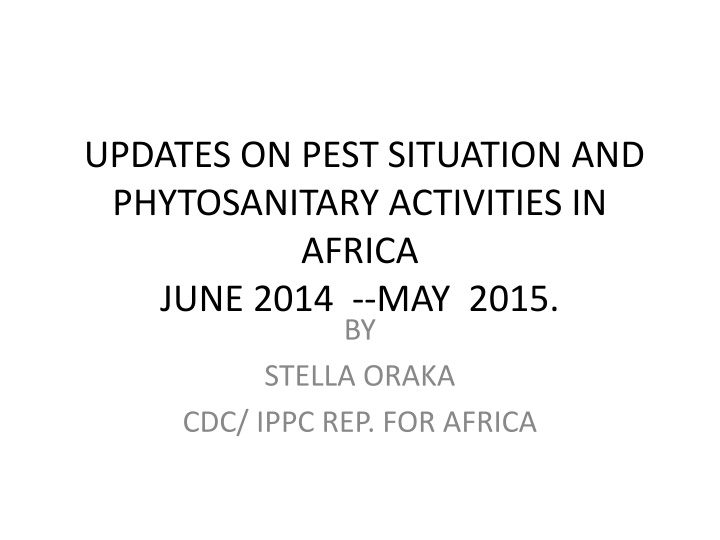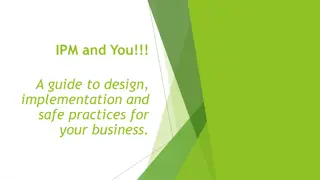Updates on Pest Situation and Phytosanitary Activities in Africa (June 2014 - May 2015)
Stella Oraka's report highlights the pest situation in Africa from June 2014 to May 2015. It covers the Locust Emergency Response Programme in Madagascar, the threat of Deadly TR4 Banana Fusarium globally, the invasion of Tuta absoluta in various regions, and the presence of Potato Cyst Nematode in Kenya. The reports emphasize the importance of coordinated international efforts to prevent and manage these invasive pests to safeguard food security and agricultural production in Africa.
Download Presentation

Please find below an Image/Link to download the presentation.
The content on the website is provided AS IS for your information and personal use only. It may not be sold, licensed, or shared on other websites without obtaining consent from the author.If you encounter any issues during the download, it is possible that the publisher has removed the file from their server.
You are allowed to download the files provided on this website for personal or commercial use, subject to the condition that they are used lawfully. All files are the property of their respective owners.
The content on the website is provided AS IS for your information and personal use only. It may not be sold, licensed, or shared on other websites without obtaining consent from the author.
E N D
Presentation Transcript
UPDATES ON PEST SITUATION AND PHYTOSANITARY ACTIVITIES IN AFRICA JUNE 2014 --MAY 2015. BY STELLA ORAKA CDC/ IPPC REP. FOR AFRICA
Situation reports of spreading invasive pests of importance Locust Emergency Response Programme in Madagascar: Food security for 13 million at risk due to locust plague. $28.8 million mobilized, $10.6 needed to complete campaign by May 2015 and avoid pest resurgence and waste of applied resources. Cost of ceasing is far greater than amount spent so far says FAO REP, Madagascar. Island also prone to drought and cyclones, may join locust plague to cause about 40% crop loss.
Globally, Deadly TR4 of Banana Fusarium in Mozambique Tropical Race 4 of Banana Fusarium wilt, Fusarium oxysporium reported in four countries in Africa, Asia, Australia, Latin America and poising to spread. Commercial variety,Cavadish fallen to disease which causes wilt and mass die-off. International experts recommend 3-prong strategy viz 1. Prevent future outbreaks, 2. Manage existing cases 3. Strenghten international colloboration and coordination.
Globally, Deadly TR4 of Banana Fusarium in Mozambique (cont d) Considered as top threat to global banana industry worth $36 billion and source of income of 400 million people. Disease is also a grave danger to food security as 85% total banana production is consumed domestically $47 million is estimated by FAO for the control work.
Tuta absoluta (tomato leaf miner Originates from South America, emerged in Europe 2006, successfully invaded parts of the European Union (EU), North Africa and some west and east African(e.g. Kenya 2014) countries. Jugding for rate of spread may enter South Africa by end of 2015. Causes yield losses of up to 50% - 100% and can rapidly develop resistance to pesticides. S.A. Plant Protection & DAFF developing early warning system for pest as part of South African Emergency Plant Pest Response Plan
Tuta absoluta (tomato leaf miner(cont d) S.A. Plant Protection & DAFF developing early warning system for pest as part of South African Emergency Plant Pest Response Plan. Presently the pest is strictly controlled through quarantine and tomato fruits should be from green vegetative parts
Potato cyst nematode (Globodera rostochiensis ) reported in Kenya Only control measure is to stop potato production in infested farms for up to 7 years but can remain for 30 years. Pest originated from Peru, occur in Algeria, Libya, Tunisia and Morocco (under quarantines. Controlled in Sierra Leone.
Controls of food security threats and pests in the Southern Africa $4 million fund better management of transboundary plant and animal pests and disease has been by African Solidarity fund to benefit 8 countries viz: Angola, Botwana, Madagascar, South Africa, Mozambique, Namibia, Zambia and Zimbabwe in Southern Africa. An initiative for mobilizing resources from Africa for Africa .
Biosecurity Project for ten African countries Australian investment The Australian International Food Security Research Centre launched of a two-year, $800,000 initiative for sub-Saharan Africa to help 10 countries become better equipped to combat plant biosecurity threats. Project covers food safety hazards, animal diseases and plant pests. chief executive of the Plant Biosecurity Cooperative Research Centre said that " pests and diseases are the single biggest threat to the quality and safety of produce in Africa, hinder economic growth and contribute to poverty.
Biosecurity Project for ten African countries Australian investment (contd) Fusarium wilt, also known as Panama disease, spread from Asia to Africa. In 2003, Bactrocera invadens, a highly destructive Asian fruit fly pest, was detected in Kenya and has spread across the continent. Tuta absoluta a tomato pest was reported for the first time in Senegal in 2012, and is moving south through the continent. "Maize lethal necrosis virus, another new example, is causing major crop losses in east. Africa. Other invasive pests: Cassava brown streak virus, banana bunchy top virus, cassava mosaic virus
Biosecurity Project for ten African countries Australian investment (contd) Are biosecurity measures getting worse? "Pests are moving a lot more now, and the preparedness of countries is weak says experts. Plant Biosecurity Capacity Development Initiative include placements of African specialists in relevant Australian institutions; workshops in Africa, mentoring programme and funding to help participants develop biosecurity action plans at national and regional level.
Fruitfly control: capacity building initiatives FAO/IAEA Regional Training Course on Fruit Fly Biocontrol in West Africa. Regional TC Project RAF5061). 2 6 March 2015, Nairobi, Kenya. FAO/IAEA Regional Meeting on SIT Application, Including Rearing, Irradiation and Release of Fruit Flies (under TC Project RAF5062). 24 26 June 2015 Reduit, Mauritius. Training course in taxonomy and systematics of Afrcan fruit flies organized by Royal Museum for Central Africa, Belgium and Sokoine University of Agriculture, Tanzania from 04-20 May 2015.
Fruitfly control: capacity building initiatives(contd) Zimbabwe Ministry of Agriculture, Mechanisation and Irrigation Development and FAO has launched a project to control fruitfly that will run till December 2015. Banks and financial institutions were also encourage to support the initiative in order for the country to surmount restrictions placed on fruit and vegetable exports by her trading partners as result of the pest.
SUCCESS STORIES Ethiopia earn $114 million from fruits and vegetable exports to EU, YEMEN, SOMALIA, DJIBOUTI, SUDAN AND OTHERS in the first 6 months. It earned $246 million in fiscal year ending july 2014. New investors come from Netherlands, India, Ecuador and Saudi Arabia. Morocco, not a food insecure country, has avoided political upheaval arising for Arab Spring, developed agriculture on two pillars viz: focus on 1.large farms and 2. small holder and family farming. Economic growth was 5% in 2011, 4.4 % in 2013.
SUCCESS STORIES(contd) West and Central African Council of Agricultural Research and Development(CORAL/WECARD) has produced 70 short films with over 8100 views on You Tube targeted at about 318 million people of which 70% live in rural areas. Viewer get a glimpse of the 55 coordinated projects putting farmers in the centre of the innovative practices and encourages learning through interchange of ideas, sucesses, failures between stakehoders.
SUCCESS STORIES(contd) Fruit Fly Africa is an industry owned service body created to plan, co-ordinate and execute area-wide fruit fly control programmes in South Africa. Area based programmes are tailor-made for specific production regions and Sterile Insect Technique (SIT) forms part of the integrated approach. Up to 14 million sterile Medfly males per week are currently produced at the Medfly mass rearing facility. Host plant management, trap setting, monitoring of FF population, Baiting of non-farm hotspots, releases of sterile fruit flies , Liaising with national and international fruit fly and SIT experts























